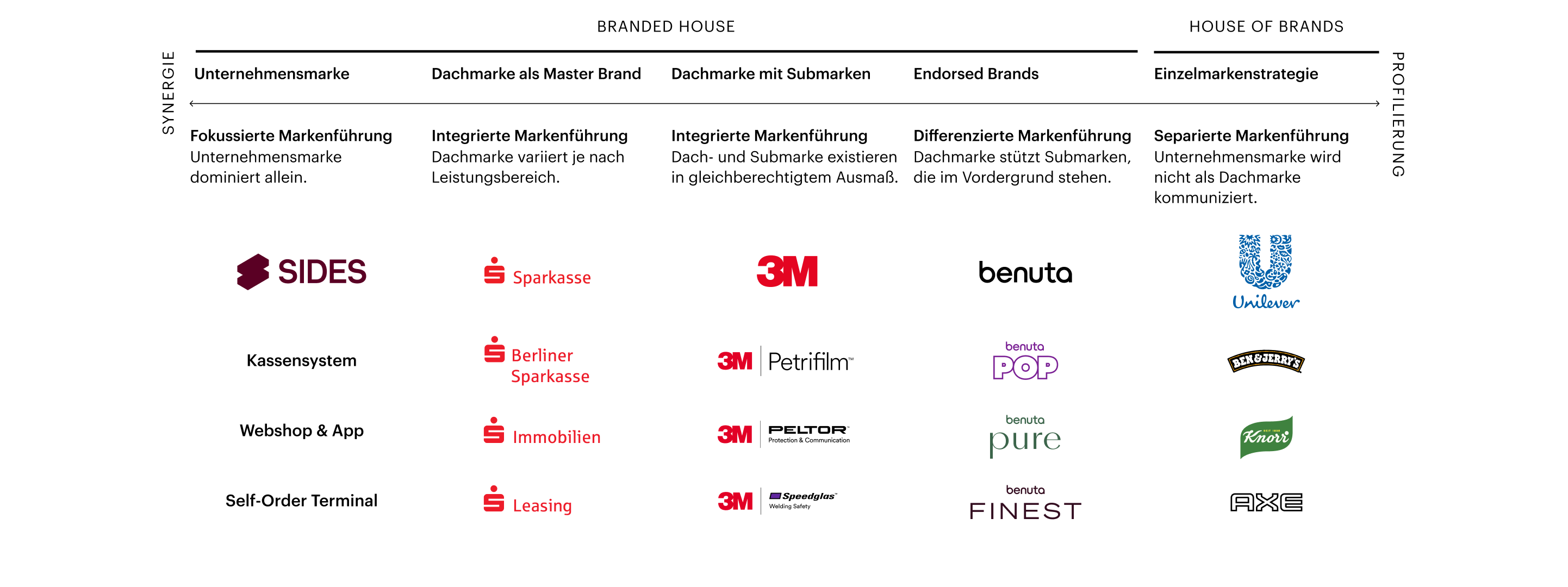Companies are becoming more complex
Many companies today are managing increasingly diverse product and service portfolios. Reasons for an increasingly complex brand architecture are a growing range of services, the acquisition of other companies, more demanding requirements in different markets, internal growth or product innovations.
Historically grown brand portfolios often have no logic that is comprehensible to customers. Therefore, at some point the question arises: are all existing brands necessary and how can the interplay between brands and company look like?

Brand architecture at first glance
Overview of frequently asked questions
The necessity of brand autonomy, maximum synergy potentials
A brand architecture is the systematic arrangement of all brands of a company to determine the positioning and the relationship between them. The goal is to use maximum synergy potentials while maintaining the necessary independence of the brands. Taking into account target groups, competencies and competitive structures, a distinction can be made between three strategies when introducing new products or services: Single brand strategy, family brand strategy and umbrella brand strategy.
Developing an intelligent brand architecture
Classic models are not always applicable on a one-to-one basis, because brand portfolios are often far more complex. Companies often grow quickly or naturally, so that clear or consistent brand presences are no longer possible. Then it is necessary to strategically scrutinize the brand diversity, possibly clean it up and design meaningful systems. For a successful brand architecture it is essential to understand how the perception of a brand is influenced by the respective other brands of a company. The goal is to develop a logic in which clear perceptions of a brand can be established with the target group despite increasing complexity. A brand architecture helps companies to define the value, positioning and focus of individual brands and thus enable targeted communication.
How to visually differentiate company, division and product?
Brand systems and structures must also be clear to customers and consumers without them having to read through pages and pages of corporate structure. An effective brand architecture includes a holistic system of NAMES, SYMBOLS, COLORS and fonts. The goal is to establish a comprehensible logic among the target groups, which on the one hand provides orientation for needs and corresponding offers. On the other hand, a comprehensible system has a positive effect on the perception and impact with customers.

We make the distinctiveness of brands perceptible.
The three most important forms of brand architecture – examples
House of Brands or single brand strategy
Here the logic applies: one product line corresponds to one brand. An example is Unilever with brands like Dove or Knorr, as well as Henkel with Persil, Weißer Riese, Pril and Pritt. The single brand strategy makes sense when a company offers many heterogeneous products that appeal to different target groups with different needs. Each of these products requires a clear focus on specific needs and a distinctive brand identity. A pointed positioning for each brand requires a high communicative effort to develop differentiated appearances for each brand.

Example of House of Brands or single brand strategy: Unilever
Branded house or umbrella brand strategy
The umbrella brand strategy is suitable for companies with a very broad focus, such as Sparkasse or Siemens. All of a company’s services are managed under a single brand. Especially if the product portfolio is very large and the target groups very diverse, the company’s competence is more in focus than the individual brand promises of the individual products. It is extremely important to strengthen the trust of customers in the brand, as individual offerings are less likely to stand out from the competition through differentiated positioning.

Example of Branded house or umbrella brand strategy: Sparkasse
Family brand strategy
Nivea is a well-known example of the family strategy, in which a uniform brand is applied to several products. New products are related, are oriented to and benefit from the already established brand image and extend the positioning with new attributes – in the case of Nivea, for example, Nivea Men or Nivea Sun. Here, it is important not to stray too far from the brand core in order not to lose credibility and the customers’ trust in the brand values. With a successful strategy, the family brand strengthens new products and saves resources through synergies in communication.
Blended house strategy
In blended strategies, corporate brands appear together with other brands, whereby either the corporate brand can dominate, or it appears on an equal footing with the other brand, e.g. Google
Endorsed Brand Strategy
In a so-called Endorsed Brand Strategy, the umbrella brand provides optimal support for the brands that stand alone. The brands have individual appearances and brand messages, but are enhanced by the “signature” of the umbrella brand to transfer already positive associations of the parent brand to the new products.
We put the brand house in order
To avoid messy communication, complex website structures, cognitive dissonance and ultimately confusion among the target audience, we support brands in developing a logical, systematic and value-added system of brand architecture. As part of our brand process, we strategically question brand strategy, clean up or restructure – then translate brand attributes into captivating brand presences.
Realign the brand family?
Let’s talk.
STRATEGY DIRECTOR